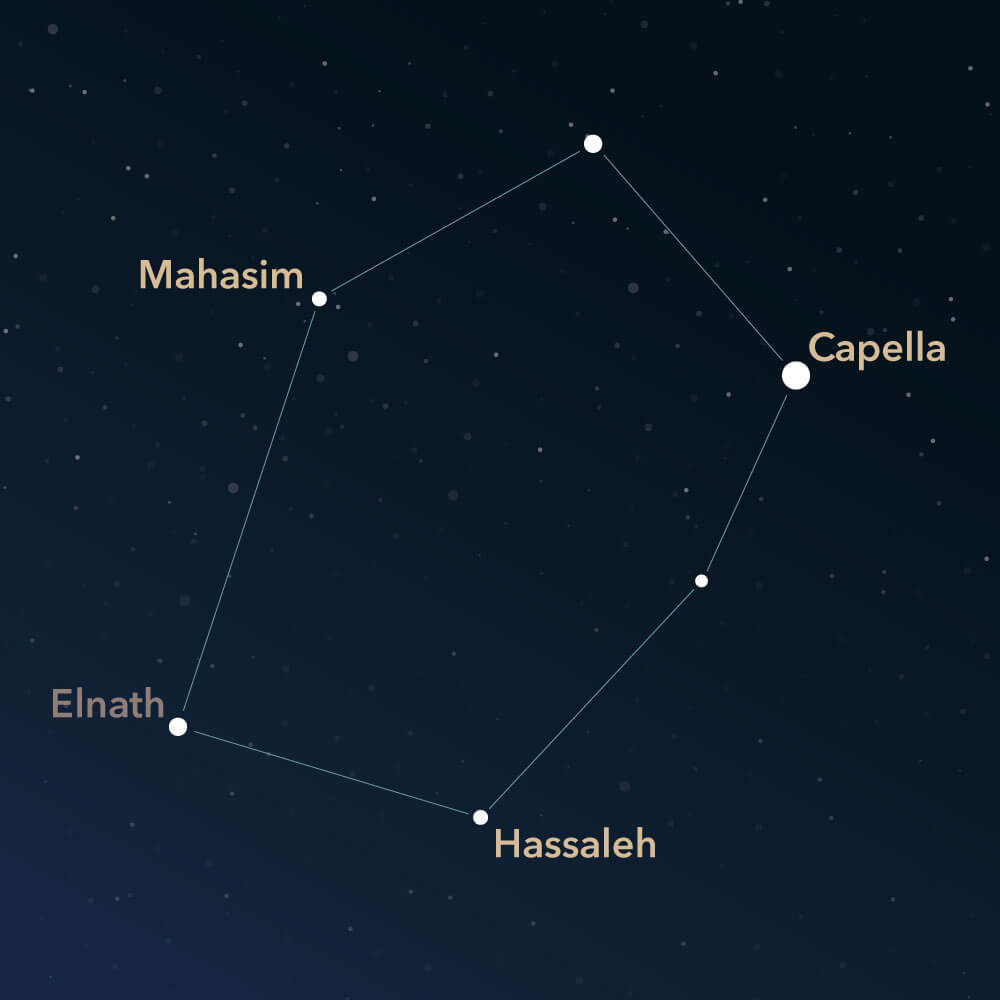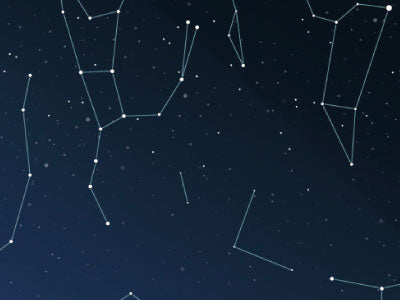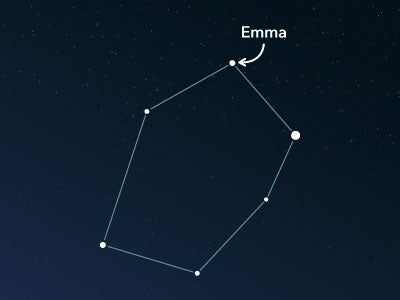The constellation Auriga
Characteristics
- Other names / Symbolism
- The Charioteer
- Hemisphere
- Northern hemisphere
- Visibility
- November - January
- Area
- 657 deg²
- Brightest star
- Capella (HIP number 24608)
- Specialties
- Open star clusters, emission nebulae, planetary nebula

The Auriga, Latin for The Charioteer, is one of the 48 constellations described by the Greco-Roman astronomer Claudius Ptolemy in ancient times. It contains some bright stars as well as impressive deep-sky objects.
Hemisphere, visibility, and area
The constellation Auriga lies in the northern sky and can be observed from many parts of the world. It is visible from anywhere in the northern hemisphere and can be seen as far south as the 34th parallel. This corresponds to locations such as Cape Town in South Africa, Santiago de Chile in Chile, or Sydney in Australia.
The best months to observe the constellation in northern latitudes are from November to January. The north part of Auriga is even circumpolar in regions such as Central Europe or Canada, meaning it is visible all year round.
It covers an area of approximately 657 square degrees of the night sky and ranks 21st compared to the other 88 constellations.
Auriga contains some very bright stars, making it easy to locate. Especially the star Capella (Latin: α Aurigae, Alpha Aurigae) shines very brightly. It has an apparent magnitude of about 0.08 and is the brightest star in Auriga. Furthermore, it is the third brightest star in the entire northern sky. It is a binary star system located approximately 43 light-years away. Capella marks the northern point of Auriga and the northernmost point of the Winter Hexagon.
Several famous constellations in the neighborhood provide good orientation, including the Taurus and Gemini, as well as Camelopardalis, Perseus, and Lynx.
Specialties in the constellation
The Milky Way runs through Auriga, which means that not only many stars can be observed, but also some exciting nebula objects.
Among them are a series of open star clusters. The three most interesting star clusters are M36, M37, and M38, named after French astronomer Charles Messier.
M36 (Messier 36), also known by the catalog number NGC 1960, consists of about 60 individual stars and can already be observed with a slightly larger pair of binoculars.
M37 (Messier 37), listed with the catalog number NGC 2099, contains around 150 stars. However, they can only be seen individually through a telescope. In binoculars, the star cluster appears as a hazy patch.
M38 (Messier 38), or NGC 1912, is composed of an interesting arrangement of about 100 stars. In binoculars, this arrangement also appears only as a hazy patch.
M36 and M38 lie between the three stars Mahasim, Hasseleh, and Elnath. The latter star officially belongs to the constellation Taurus. M37 is located south of the star Mahasim.

Near M36 are two emission nebulae, NGC 1931 and IC 405. The former was discovered in 1793 by the German-British astronomer William Herschel and can already be perceived as a reddish glowing nebula with a smaller telescope.
In addition to that, further objects can be observed, including a planetary nebula.
Mythology
There are many different approaches to the mythological origins of the constellation Auriga, and the constellation is identified quite differently. Two interpretations are explained in more detail below.
The Romans recognized in the constellation Erichthonius, the inventor of the four-horse chariot and the paralyzed son of the god Vulcan. The goddess Athena taught him how to handle horses at a young age, and he quickly became an excellent racer, eventually being placed in the sky for his achievements.
In Greece, however, Auriga represented Myrtilus who was responsible for the racing team of King Oenomaus. The king raced against any man who wanted to marry his daughter Hippodamia. If he lost, he was killed in front of everyone.
Since Oenomaus drove the fastest chariot in the entire kingdom, thanks to Myrtilus, Hippodamia lost hope of ever being able to marry. However, after a few years, she met the beautiful Pelops and fell madly in love with him. She decided to manipulate the race with the help of Myrtilus.
Knowing that Myrtilus was in love with her, she promised him the wedding night if he helped her. He gladly accepted the deal, loosened the screws of the king's racing chariot, and so the disaster took its course. Oenomaus had a fatal accident, and Pelops lured Myrtilus onto a rock to push him down and drown him.
PublishedRead more interesting articles

An overview of all 88 constellations
Learn more about all 88 constellations and read interesting information about the mythology, visibility, and features.

Planetarium App
Discover the night sky with our planetarium app!
Available for iOS and Android.

Name a star in the constellation Auriga
Name a star in a constellation and create something that lasts for eternity.